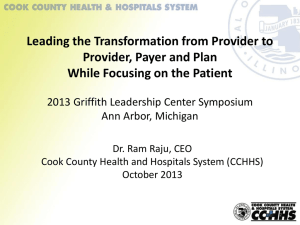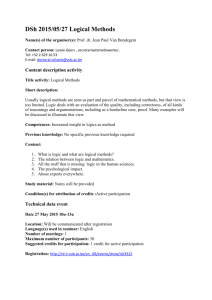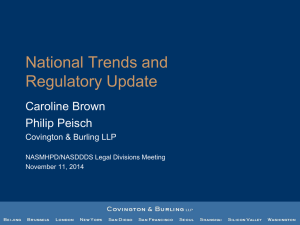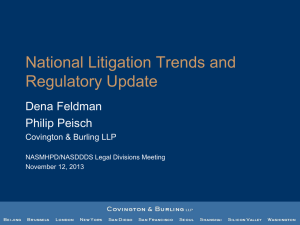Presentation MN - MHA- final
advertisement
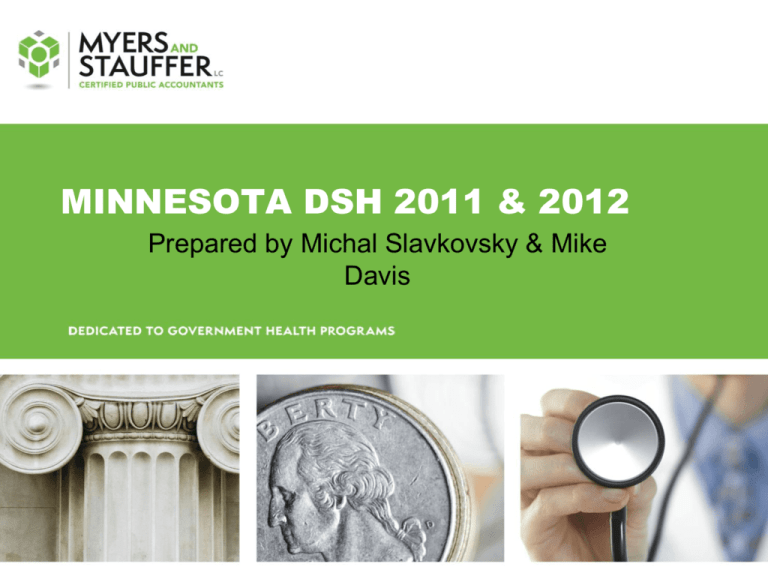
MINNESOTA DSH 2011 & 2012 Prepared by Michal Slavkovsky & Mike Davis AGENDA • Introduction to MYERS and STAUFFER • Project Timeline • SFTP Site • Audit Approach • DSH Examination Surveys • Review process • Clarifications • Issues in Other States • FAQ INTRODUCTION TO MYERS AND STAUFFER • 18 offices serving 46 states • 700 employees • DSH audits for 38 states including MN BOISE OFFICE • 27 employees • DSH states – Alaska, Idaho, Montana, North Dakota, Wyoming, and Minnesota MN DSH CONTACTS Myers and Stauffer Contact Listing Name Tammy Martin Title Member Responsible for Contracts Pricing Project Oversight & Management Email tammym@mslc.com Phone Direct: 208.685.1567 Toll free 800.336.7721 Michal "Michael" Slavkovsky Manager Day-to-day project Michals@mslc.com management. Primary state contact Karen Calhoon Sr. Manager Oversees project, backup to Michal Kcalhoon@mslc.com Toll free 800.336.7721 Mike Davis Manager Oversees project, backup to Michal Mdavis@mslc.com Toll free 800.336.7721 Direct: 208.685.1570 Toll free 800.336.7721 PROJECT TIMELINE Milestone Receive from state (DSH surveys can’t be prepared for mailing until this minimum list is received) listing of providers, Medicare numbers, DSH payment by hospital, contact names and addresses, and cost reporting years that fall into DSH year. Meet with hospital association to introduce ourselves and discuss the survey and audit process. Target Start Target End Requested 6/10/15 Anticipated receipt date 6/18/15 (the following target dates are based on receipt on this date) 6/23/15 webinar Prepare surveys customized to MN. Obtain MCR cost reports from HFS software system and HCRIS. Upload MCR cost report data to each provider’s survey using HCRIS. Prepare surveys for mailing. 06/16/15 06/30/15 Mail surveys and survey instructions to providers for them to complete and submit to us for audit. Give them 4 weeks to submit the completed surveys. 06/30/15 07/28/15 Schedule provider survey training (webinar) Week beginning 7/6/15 Conduct desk reviews on surveys. 07/28/15 09/30/15 Using risk based approach, select providers for expanded review and perform additional audit procedures and inquiries. 09/30/15 10/31/15 Perform senior management reviews of audits. 07/28/15 10/31/15 Issue adjusted surveys to providers for their review. 07/28/15 10/31/15 Prepare draft audit report for submission to DHS. 10/31/15 11/30/15 Schedule exit conference with DHS to discuss draft report and findings. Make revisions to report as needed as a result of the exit conference – issue final report for submission to CMS. By 12/15/15 12/28/15 PROVIDER SURVEY TRAINING (WEBINAR) • Week beginning 7/6/15 • More detailed training on how to fill out the survey and what supporting documents will need to be provided • Therefore, today’s training will not be focused on details of how to fill out the surveys • Any questions from this point on will be added to Q&A document that will be available on MSLC website and will be updated every few days • Will also add those FAQs to the later webinar training SECURE FILE TRANSFER PROTOCOL (SFTP) SITE • MYERS and STAUFFER website allowing secure transfer of data between the parties • We encourage the providers to have the accounts set up as this will reduce time needed to exchange data • Each provider will have their own account and they will be able to download/upload files SECURE FILE TRANSFER PROTOCOL (SFTP) SITE IMMEDIATE SIGN UP • SFTP – Joe Schindler at MHA is to send us a contact list • Providers need to add MSLC.COM domain as a trusted sender • MSLC will email providers SFTP paper work for them to sign as soon as possible • If we can get the accounts set up fast, we will be able to send the survey mailings through the SFTP site instead of CDs AUDIT APPROACH • Utilize an excel survey document to gather needed data • Detailed training on the survey document to be announced later. • Today just a high level overview • MSLC pre-populates cost report years and Medicare cost report fields • Provider populates the rest DSH EXAMINATION SURVEYS General Instruction – Survey Files • The survey is split into 2 separate Excel files: • DSH Survey Part I – DSH Year Data. • DSH year-specific information. • Always complete one copy. • DSH Survey Part II – Cost Report Year Data. • Cost report year-specific information. • Complete a separate copy for each cost report year needed to cover the DSH year. • Hospitals with year end changes or that are new to DSH may have to complete 2 or 3 year ends. DSH EXAMINATION SURVEYS General Instruction – Survey Files • Don’t complete a DSH Part II survey for a cost report year already submitted in a previous DSH exam year. • Example: Hospital A provided a survey for their year ending 12/31/11 with the DSH audit of SFY 2011 in the prior year. In the DSH year 2012 exam, Hospital A would only need to submit a survey for their year ending 12/31/12. • Both surveys have an Instructions. Please refer to those tabs if you are unsure of what to enter in a section. If it still isn’t clear, please contact Myers and Stauffer. DSH EXAMINATION SURVEYS General Instruction – HCRIS Data • Myers and Stauffer will pre-load certain sections of Part II of the survey using the Healthcare Cost Report Information System (HCRIS) data from CMS. However, the hospital is responsible for reviewing the data to ensure it is correct and reflects the best available cost report (audited if available). • Hospitals that do not have a Medicare cost report on file with CMS will not see any data pre-loaded and will need to complete all lines as instructed. DSH SURVEY PART I – DSH YEAR DATA Section A • DSH Year should already be filled in. • Hospital name may already be selected (if not, select from the drop-down box). • Verify the cost report year end dates (should only include those that weren’t previously submitted). • If these are incorrect, please call Myers and Stauffer and request a new copy. Section B • Answer all OB questions using drop-down boxes. DSH SURVEY PART I – DSH YEAR DATA Section C • Report any Medicaid supplemental payments, including UPL and Non-Claim Specific payments, for the state fiscal year. Do NOT include DSH payments. Certification • Answer the “Retain DSH” question but please note that IGTs and CPEs are not a basis for answering the question “No”. • Enter contact information. • Have CEO or CFO sign this section after completion of Part II of the survey. DSH YEAR SURVEY PART II SECTION D – GENERAL INFORMATION Submit one copy of the Part II survey for each cost report year not previously submitted. • Question #2 – An “X” should be shown in the column of the cost report year survey you are preparing. • • • If you have multiple years listed, you will need to prepare multiple surveys). If there is an error in the year ends, contact Myers and Stauffer to send out a new copy. Question #3 – This question may be already answered based on pre-loaded HCRIS data. If your hospital is going to update the cost report data to a more recent version of the cost report, select the status of the cost report you are using with this drop-down box. DSH YEAR SURVEY PART II SECTION E, MISC. PAYMENT INFO. • 1011 Payments - You must report your Section 1011 payments included in payments on Exhibit B (posted at the patient level), and payments received but not included in Exhibit B (not posted at the patient level), and separate the 1011 payments between hospital services and non-hospital services (non-hospital services include physician services). • If your facility received DSH payments from another state (other than your home state) these payments must be reported on this section of the survey (calculate amount for the cost report period). • Enter in total cash basis patient payment totals from Exhibit B as instructed. These are check totals to compare to the supporting Exhibit B. DSH YEAR SURVEY PART II SECTION F MIUR/LIUR • The state must report your actual MIUR and LIUR for the DSH year - data is needed to calculate the MIUR/LIUR. • Section F-1: Total hospital days from cost report. Myers and Stauffer will pre-load CMS HCRIS cost report data into this section. If it is incorrect or doesn’t agree to a more recently audited version of the cost report, please correct as needed and update question #3 in Section D. • Section F-2: If cash subsidies are specified for I/P or O/P services, record them as such, otherwise record entire amount as unspecified. • Section F-2: Report charity care charges based on your own hospital financials or the definition used for your state DSH payment (support must be submitted). DSH YEAR SURVEY PART II SECTION F, MIUR/LIUR Section F-3: Report hospital revenues and contractual adjustments. • Myers and Stauffer will pre-load CMS HCRIS cost report data into this section. If it is incorrect or doesn’t agree to a more recently audited version of the cost report, please correct as needed and update question #3 in Section D. • Totals should agree with the cost report worksheets G-2 and G-3. If not, provide an explanation with the survey. • Contractuals by service center are set-up to calculate based on total revenues and the total contractuals from G-3. If you have contractuals by service center or the calculation does not reasonably state the contractual split between hospital and nonhospital, overwrite the formulas as needed and submit the necessary support. DSH YEAR SURVEY PART II SECTION F, MIUR/LIUR Section F-3: Reconciling Items Necessary for Proper Calculation of LIUR • Bad debt and charity care write-offs not included on G-3, line 2 should be entered on lines 28 and 29 so they can be properly excluded in calculating net patient service revenue utilized in the LIUR. • Medicaid DSH payments and state and local patient care cash subsidies included on G-3, line 2 should be entered on line 30 and 31 so they can be properly excluded in calculating net patient service revenue also. • Medicaid Provider Tax included on G-3, line 2 should be entered on line 32 so it can be properly excluded in calculating net patient service revenue. DSH YEAR SURVEY PART II SECTION G, COST REPORT DATA • Calculation of Routine Cost Per Diems • Days • Cost • Calculation of Ancillary Cost-to-Charge Ratios • Charges • Cost DSH SURVEY PART II SECTION H, IN-STATE MEDICAID • Enter inpatient (routine) days, I/P and O/P charges, and payments. The form will calculate cost and shortfall / long-fall for: • In-State FFS Medicaid Primary (Traditional Medicaid). • In-State Medicaid Managed Care Primary (Medicaid MCO). • In-State Medicare FFS Cross-Overs (Traditional Medicare with Traditional Medicaid Secondary). • In-State Other Medicaid Eligibles (May include other Medicaid not included elsewhere). DSH SURVEY PART II SECTION H, IN-STATE MEDICAID • Medicaid Payments Include: • Claim payments. • Medicaid cost report settlements. • Medicare bad debt payments (cross-overs). • Medicare cost report settlement payments (cross-overs). • Other third party payments (TPL). DSH SURVEY PART II SECTION H, IN-STATE MEDICAID • Summary data at revenue code level will be provided by DHS • Providers will need to cross-walk the data onto the survey using the cross-walk they used for Medicare cost reporting purposes • MSLC will calculate the settlement for CAHs OP claims at 101% subject to ratable deductions. DSH SURVEY PART II SECTION H, MEDICARE FFS CROSS-OVERS • Charges, days, and Medicaid payments will be filled out by the providers from the support provided by DHS • MSLC will calculate Medicare payments if the providers (non-CAHs) cannot query Medicare payments or they appear unreasonable • MSLC uses a workpaper that calculates Medicare payments based on Medicare cost report • For CAHs – payments will be calculated at 101% of costs (reduction of 2% as of 04/01/2013) DSH SURVEY PART II SECTION H, UNINSURED • Report uninsured services, patient days (by routine cost center) and ancillary charges by cost center. • Survey form Exhibit A shows the data elements that need to be collected and provided to Myers and Stauffer. • For uninsured payments, enter the uninsured hospital patient payment totals from your Survey form Exhibit B. Do NOT pick up the non-hospital or insured patient payments in Section H even though they are reported in Exhibit B. DSH SURVEY PART II SECTION H, UNINSURED • If BOTH of the following conditions are met, a hospital is NOT required to submit any uninsured data on the survey nor Exhibits A and B: 1. The hospital Medicaid shortfall is greater than the hospital’s total Medicaid DSH payments for the year. • 2. The shortfall is equal to all Medicaid (FFS, MCO, cross-over, In-State, Out-of-State) cost less all applicable payments in the survey and non-claim payments such a UPL, GME, outlier, and supplemental payments. The hospital provides a certification that it incurred additional uncompensated care costs serving uninsured individuals. DSH SURVEY PART II SECTION H, UNINSURED NOTE: It is important to remember that if you are not required to submit uninsured data that it may still be to the advantage of the hospital to submit it. 1. Your hospital’s total UCC may be used to redistribute overpayments from other hospitals (to your hospital). 2. Your hospital’s total UCC may be used to establish future DSH payments. 3. CMS DSH allotment reductions are partially based on states targeting DSH payments to hospitals with high uninsured and Medicaid populations. REVIEW PROCESS • During the review process, hospitals might be contacted for additional information. To reduce the time spent on requesting items that should be sent with the surveys, the providers need to make sure they send us the items that are noted on the CHECKLIST that is included with Survey Part 1 (grouping support, x-walk, Exhibits, charity care, subsidies, etc.) CLARIFICATIONS • December 3, 2014 Final Rule • Definitions of uninsured as laid out in the January 2012 proposed rule have been finalized. • Myers and Stauffer has been utilizing the definitions of uninsured as stated in the January 2012 proposed rule since the 2009 DSH examinations. • Now that the proposed rule has been finalized, Myers and Stauffer will continue to utilize those definitions as they have been since the 2009 DSH examinations. • For details and examples of the definition of uninsured based on the December 3, 2014 Final Rule, see the “Uninsured Definitions” tab of DSH Survey Part II. CLARIFICATIONS • The 2008 DSH rule and January, 2010 CMS FAQ #33 both require that a hospital’s DSH uncompensated care cost include all Other Medicaid Eligibles. • The 2008 DSH rule specifically states that the UCC calculation must include “regular Medicaid payments, Medicaid managed care organization payments, supplemental/enhanced Medicaid payments, uninsured revenues, and 1011 payments.” FR Vol. 73, No. 245, Friday, Dec. 19, 2008, Final Rule, 77904 • January, 2010 CMS FAQ #33 was issued on January 10, 2010, and clarified that the Other Medicaid Eligible population includes patients with private insurance who are dually eligible for Medicaid, and that any payments from private insurance must be included in the UCC calculation. (See question and answers at the end of this presentation.) • Seattle Children’s and Texas Children’s Hospitals have sued to stop recoupments of their DSH overpayments that have resulted from the inclusion of these private insurance claims in their DSH UCC. On December 29, 2014, a federal court ordered an injunction against Washington and Texas state Medicaid agencies and CMS preventing the state and/or CMS from recouping the overpayments as included in the DSH examination report. CLARIFICATIONS • This does not change how Myers and Stauffer or any other independent CPA firm must calculate a hospital’s uncompensated care cost for the 2012 DSH examinations at this time. • Until new CMS audit guidance is issued, we must continue to calculate each hospital’s UCC including all Other Medicaid Eligibles (including those with private insurance). • However, we do recommend that you submit your Other Medicaid Eligibles exactly as requested in Exhibit C. Specifically, ensure that you separately identify each claims Medicaid, Medicare, Third Party Liability (TPL), and Self-Pay payments into their individual columns as laid out in the Exhibit A-C template that was provided on your disc. COMMON ISSUES NOTED DURING EXAMINATION IN OTHER STATES • Hospitals had duplicate patient claims in the uninsured, cross-over, and state’s Medicaid FFS data. • Patient payor classes that were not updated. (ex. a patient was listed as self-pay and it was determined that they later were Medicaid eligible and paid by Medicaid yet the patient was still claimed as uninsured). • Incorrectly reporting elective (cosmetic surgeries) services, and non-Medicaid untimely filings as uninsured patient claims. COMMON ISSUES NOTED DURING EXAMINATION IN OTHER STATES • Charges and days reported on survey exceeded total charges and days reported on the cost report (by cost center). • Inclusion of patients in the uninsured charges listing (Exhibit A) that are concurrently listed as insured in the payments listing (Exhibit B). • Patients listed as both insured and uninsured in Exhibit B for the same dates of service. COMMON ISSUES NOTED DURING EXAMINATION IN OTHER STATES Common Issues Noted During Examination • Patient-level documentation on uninsured Exhibit A and uninsured patient payments from Exhibit B didn’t agree to totals on the survey. • Under the December 3, 2014 final DSH rule, hospitals reported “Exhausted” / “Insurance Non-Covered” on Exhibit A (Uninsured) but did not report the payments on Exhibit B. COMMON ISSUES NOTED DURING EXAMINATION IN OTHER STATES • “Exhausted” / “Insurance Non-Covered” reported in uninsured incorrectly included the following: • Services partially exhausted. • Denied due to timely filing. • Denied for medical necessity. • Denials for pre-certification. COMMON ISSUES NOTED DURING EXAMINATION IN OTHER STATES • Exhibit B – Patient payments didn’t always include all patient payments – some hospitals incorrectly limited their data to uninsured patient payments. • Some hospitals didn’t include their charity care patients in the uninsured even though they had no third party coverage. COMMON ISSUES NOTED DURING EXAMINATION IN OTHER STATES • Medicare cross-over payments didn’t include all Medicare payments (outlier, cost report settlements, lump-sum/pass-through, payments received after year end, etc.). • Only uninsured payments are to be on cash basis – all other payor payments must include all payments made for the dates of service as of the audit date. COMMON ISSUES NOTED DURING EXAMINATION IN OTHER STATES • Liability insurance claims were incorrectly included in uninsured even when the insurance (e.g., auto policy) made a payment on the claim. • Hospitals didn’t report their charity care in the LIUR section of the survey or didn’t include a break-down of inpatient and outpatient charity. FAQ 1. What is the definition of uninsured for Medicaid DSH purposes? Uninsured patients are individuals with no source of third party health care coverage (insurance) for the specific inpatient or outpatient hospital service provided. Prisoners must be excluded. • On December 3, 2014, CMS finalized the proposed rule published on January 18, 2012 Federal Register to clarify the definition of uninsured and prisoners. • Under this final DSH rule, the DSH examination looks at whether a patient is uninsured using a “service-specific” approach. • Based on the 2014 final DSH rule, the survey allows for hospitals to report “fully exhausted” and “insurance non-covered” services as uninsured. FAQ 1. What is the definition of uninsured for Medicaid DSH purposes? (Continued from previous slide) Excluded prisoners were defined in the 2014 final DSH rule as: • Individuals who are inmates in a public institution or are otherwise involuntarily held in secure custody as a result of criminal charges. These individuals are considered to have a source of third party coverage. • Prisoner Exception • If a person has been released from secure custody and is referred to the hospital by law enforcement or correction authorities, they can be included. • The individual must be admitted as a patient rather than an inmate to the hospital. • The individual cannot be in restraints or seclusion. FAQ 2. What is meant by “Exhausted” and “Non-Covered” in the uninsured Exhibits A and B? Under the December 3, 2014 final DSH rule, hospitals can report services if insurance is “fully exhausted” or if the service provided was “not covered” by insurance. The service must still be a hospital service that would normally be covered by Medicaid. FAQ 3. What categories of services can be included in uninsured on the DSH survey? Services that are defined under the Medicaid state plan as a Medicaid inpatient or outpatient hospital service may be included in uninsured. (Auditing & Reporting pg. 77907 & Reporting pg. 77913) • There has been some confusion with this issue. CMS attempts to clarify this in #24 of their FAQ titled “Additional Information on the DSH Reporting and Audit Requirements”. It basically says if a service is a hospital service it can be included even if Medicaid only covered a specific group of individuals for that service. • EXAMPLE : A state Medicaid program covers speech therapy for beneficiaries under 18 at a hospital. However, a hospital provides speech therapy to an uninsured individual over the age of 18. Can they include it in uninsured? The answer is “Yes” since speech therapy is a Medicaid hospital service even though they wouldn’t cover beneficiaries over 18. FAQ 4. Can a service be included as uninsured, if insurance didn’t pay due to improper billing, late billing, or lack of medical necessity? No. Improper billing by a provider does not change the status of the individual as insured or otherwise covered. In no instance should costs associated with claims denied by a health insurance carrier for such a reason be included in the calculation of hospital-specific uncompensated care (would include denials due to medical necessity). (Reporting pages 77911 & 77913) FAQ 5. Can unpaid co-pays or deductibles be considered uninsured? No. The presence of a co-pay or deductible indicates the patient has insurance and none of the co-pay or deductible is allowable even under the 2014 final DSH rule. (Reporting pg. 77911) 6. Can a hospital report their charity charges as uninsured? Typically a hospital’s charity care will meet the definition of uninsured but since charity care policies vary there may be exceptions. If charity includes unpaid co-pays or deductibles, those cannot be included. Each hospital will have to review their charity care policy and compare it to the DSH rules for uninsured. FAQ 7. Can bad debts be considered uninsured? Bad debts cannot be considered uninsured if the patient has third party coverage. The exception would be if they qualify as uninsured under the 2014 final DSH rule as an exhausted or insurance non-covered service (but those must be separately identified). FAQ 8. How do IMDs (Institutes for Mental Disease) report patients between 22-64 that are not Medicaid-eligible due to their admission to the IMD? • Many states remove individuals between the ages of 22 and 64 from Medicaid eligibility rolls; if so these costs should be reported as uncompensated care for the uninsured. If these individuals are reported on the Medicaid eligibility rolls, they should be reported as uncompensated care for the Medicaid population. (Reporting pg. 77929 and CMS Feb. 2010 FAQ #28 – Additional Information on the DSH Reporting and Audit Requirements) • Per CMS FAQ, if the state removes a patient from the Medicaid rolls and they have Medicare, they cannot be included in the DSH UCC. • Under the 2014 final DSH rule, these patients may be included in the DSH UCC if Medicare is exhausted. FAQ 9. Can a hospital report services covered under automobile polices as uninsured? Not if the automobile policy pays for the service. We interpret the phrase ‘‘who have health insurance (or other third party coverage)’’ to broadly refer to individuals who have creditable coverage consistent with the definitions under 45 CFR Parts 144 and 146, as well as individuals who have coverage based upon a legally liable third party payer. The phrase would not include individuals who have insurance that provides only excepted benefits, such as those described in 42 CFR 146.145, unless that insurance actually provides coverage for the hospital services at issue (such as when an automobile liability insurance policy pays for a hospital stay). (Reporting pages 77911 & 77916) FAQ 10. How are patient payments to be reported on Exhibit B? Cash-basis! Exhibit B should include patient payments collected during the cost report period (cash-basis). Under the DSH rules, uninsured cost must be offset by uninsured cash-basis payments. 11.Does Exhibit B include only uninsured patient payments or ALL patient payments? ALL patient payments. Exhibit B includes all cash-basis patient payments so that testing can be done to ensure no payments were left off of the uninsured. The total patient payments on Exhibit B should reconcile to your total selfpay payments collected during the cost report year. FAQ 12.Should we include state and local government payments for indigent in uninsured on Exhibit B? Uninsured payments do not include payments made by State-only or local only government programs for services provided to indigent patients (no Federal share or match). (Reporting pg. 77914) 13.Can physician services be included in the DSH survey? Physician costs that are billed as physician professional services and reimbursed as such should not be considered in calculating the hospital-specific DSH limit. (Reporting pg. 77924) FAQ 14.Do dual eligibles (Medicare/Medicaid) have to be included in the Medicaid UCC? Yes. CMS believes the costs attributable to dual eligible patients should be included in the calculation of the uncompensated care costs, but in calculating the uncompensated care costs, it is necessary to take into account both the Medicare and Medicaid payments made. In calculating the Medicare payment, the hospital should include all Medicare adjustments (DSH, IME, GME, etc.). (Reporting pg. 77912) 15.Does Medicaid MCO and Out-of-State Medicaid have to be included? Yes. Under the statutory hospital-specific DSH limit, it is necessary to calculate the cost of furnishing services to the Medicaid populations, including those served by Managed Care Organizations (MCO), and offset those costs with payments received by the hospital for those services. (Reporting pages 77920 & 77926) FAQ 16.Do Other Medicaid Eligibles (Private Insurance/Medicaid) have to be included in the Medicaid UCC? Days, costs, and revenues associated with patients that are dually eligible for Medicaid and private insurance should be included in the calculation of the Medicaid inpatient utilization rate (MIUR) for the purposes of determining a hospital eligible to receive DSH payments. Section 1923(g)(1) does not contain an exclusion for individuals eligible for Medicaid and also enrolled in private health insurance. Therefore, days, costs and revenues associated with patients that are eligible for Medicaid and also have private insurance should be included in the calculation of the hospital-specific DSH limit. (January, 2010 CMS FAQ 33 titled, “Additional Information on the DSH Reporting and Audit Requirements”) FAQ 16.Do Other Medicaid Eligibles (Private Insurance/Medicaid) have to be included in the Medicaid UCC? Days, costs, and revenues associated with patients that are dually eligible for Medicaid and private insurance should be included in the calculation of the Medicaid inpatient utilization rate (MIUR) for the purposes of determining a hospital eligible to receive DSH payments. Section 1923(g)(1) does not contain an exclusion for individuals eligible for Medicaid and also enrolled in private health insurance. Therefore, days, costs and revenues associated with patients that are eligible for Medicaid and also have private insurance should be included in the calculation of the hospital-specific DSH limit. (January, 2010 CMS FAQ 33 titled, “Additional Information on the DSH Reporting and Audit Requirements”) QUESTIONS?
